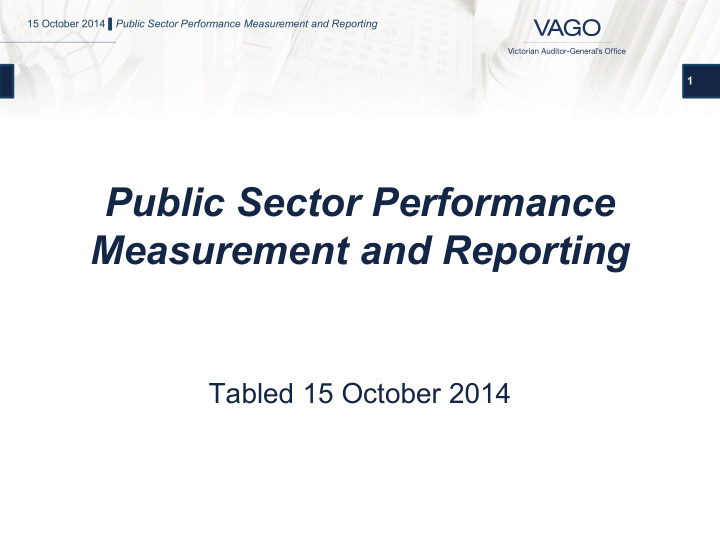



15 October 2014 ▌ Public Sector Performance Measurement and Reporting 1 Public Sector Performance Measurement and Reporting Tabled 15 October 2014
15 October 2014 ▌ Public Sector Performance Measurement and Reporting Background 2 • Performance measurement and reporting is critical to: page • informing government ix • improving performance • helping Parliament and the community • enhancing transparency pages • VAGO/Public Accounts and Estimates Committee highlighted 2–3 systemic weaknesses. • Reforms from 2011–12 are meant to: • define objectives and link to outputs using objective indicators page ix • develop medium- and long-term plans. Current Victorian requirements, if effectively applied, would represent better practice.
15 October 2014 ▌ Public Sector Performance Measurement and Reporting The audit 3 page Examined whether: 9 • The following departments were effectively applying government’s system to measure and communicate performance: • Department of Health (DH) • Department of Transport Planning and Local Infrastructure ( DTPLI) • Department of Premier and Cabinet (DPC). • The Department of Treasury and Finance (DTF) was effectively guiding, supporting and overseeing the application of this system. Are the government’s reforms making the intended difference to performance measurement and reporting?
15 October 2014 ▌ Public Sector Performance Measurement and Reporting Departments not effectively applying the system 4 page Budget papers and annual reports are impenetrable: 34 • Lots of metrics on output performance. • No complete picture of output effectiveness and efficiency. • Weaknesses linking outputs to well-defined objectives. • Absence of meaningful commentary. page page 37 Weaknesses in analysis provided to government: 34 • More extensive in analysing output measure changes. • However, structural weaknesses remain and no linkage to objectives. Current documentation is of minimal value in explaining departments’ performance.
15 October 2014 ▌ Public Sector Performance Measurement and Reporting Departments not effectively applying the system – continued 5 Slow progress to develop corporate and long-term plans. pages 27–28 • Draft corporate plans useful but compromised in terms of: • describing performance and explaining emerging risks • describing planned actions and reforms, and the options for addressing emerging risks. pages • Long-term plan paused because of: 29–30 • inconsistent quality—capability, compliance focus • failure to provide plans to DTF on time. • DTF proposed alternative approach to long-term planning. Poor progress in planning increases the possibility of unmitigated risks for agencies and may cast doubt on the reliability of information provided.
15 October 2014 ▌ Public Sector Performance Measurement and Reporting DTF’s oversight and support have been partly effective 6 page On a positive note, DTF has: 32 • communicated government requirements and supported departments • tested compliance and communicated to departments and government. However, DTF needs to improve by: • providing more extensive better practice examples • more rigorously assessing and reporting on departments • better understanding and addressing ‘barriers’. DTF needs to improve how it guides and oversees the development of the system.
15 October 2014 ▌ Public Sector Performance Measurement and Reporting Way forward—overcoming barriers to change 7 pages Identified barriers: 33–34 • Constraints in linking outputs to objectives—aggregation and continuity. • Current structure/intent of budget papers and annual reports. • Defining objectives and objective indicators—lack of detailed examples. • Challenges in getting ministerial buy-in to framework changes. DTF and departments have not addressed these barriers: • ‘Compliance’ without achieving the government’s intent. • Departments need to design a system that fully meets requirements. • DTF support for departments’ transition to a fit-for-purpose system. This won’t happen with a ‘business as usual’ approach. It requires DTF and departments to be proactive and focused.
15 October 2014 ▌ Public Sector Performance Measurement and Reporting Recommendations 8 Accept 1. That DH, DTPLI and DPC design, without being constrained by past performance measures, a performance measurement and reporting system that fully meets the government's requirements. 2. That DTF and portfolio departments work together to: • understand the barriers that hinder departments from fully applying the government's system • assess the options for overcoming these barriers including whether performance against outcomes should complement and be reported separately from Budget Papers, annual reports and corporate plans • agree and apply a strategy to transition departments to a performance measurement and reporting system that meets government's requirements. 3. That DTF and portfolio departments work together to determine how to deliver 2015–16 plans that are fit for purpose, by identifying deficiencies in current plans and agreeing how to overcome the barriers to addressing these.
15 October 2014 ▌ Public Sector Performance Measurement and Reporting Recommendations – continued 9 Accept That DTF: 4. complete its work on the medium- to long-term challenges facing Victoria—by modelling the likely impacts of future fiscal, economic and demographic trends—so that it is ready to improve long-term planning once government decides how to proceed 5. improve the guidance material on performance measurement to include more practical examples to help departments measure efficiency and effectiveness and link outputs to departmental objectives 6. more rigorously and consistently assess and communicate performance back to portfolio departments and government.
15 October 2014 ▌ Public Sector Performance Measurement and Reporting Relevant reports 10 • Performance Reporting by Departments, May 2010. • Performance Management and Reporting , April 2003. • Departmental Performance Management and Reporting , November 2001. • Reflections on audits 2006–12: Lessons from the past, challenges for the future— Auditing in the Public Interest newsletter, 2012.
15 October 2014 ▌ Public Sector Performance Measurement and Reporting Contact details 11 For further information on this presentation please contact: Victorian Auditor-General’s Office [p] 8601 7000 [w] www.audit.vic.gov.au/about_us/contact_us.aspx
Recommend
More recommend